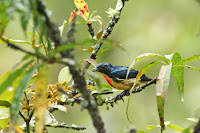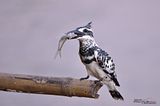Finally finished processing photos from the trip to Doi Angkang last weekend. Though we couldn't go out birding that much because of the rain, we still got quite a surprising number of birds in our list, 73 species in 3 days. I took lots of photos but not so many species. I find that most of the birds that I could successfully take photos of were small birds. I think it was because small birds are easier to approach than larger birds, which tend to fly away as soon as they see human. Though being easier to approach, these small birds are in contrast much tougher to put nicely in a frame since they always tend to move rapidly among the branches and twigs.
I spent the second day chasing the above Fire-breasted Flowerpecker (Dicaeum ignipectum) at Nor Lae military camp's orchard. The male bird is very beautiful with its glossy green upperparts contrasting with buffish underparts and bright scarlet breast patch. It is very tiny, only about 10cm in length, thus very difficult to get decent shots. I noticed that it often came to a specific fruiting mistletoe, so I sat there and waited for the bird to come and successfully got some decent photos. As we all know that mistletoe is a parasitic plant, its seeds that come out along with the bird's droppings can gradually grow up on the branches where these droppings were attached to. Like the photos above, the green seeds with sticky liquid hanging from a twig are the seeds of mistletoe that came out with the dropping.
The female bird is plain brownish with slightly buffier underparts. She later came to the mistletoe and chased away the male bird which was feeding earlier there. I was a little bit angry on her, since I was still greatly enjoying photographing her beautiful mate, so I just had no choice but to take photos of this plain brownish female.






The female bird is plain brownish with slightly buffier underparts. She later came to the mistletoe and chased away the male bird which was feeding earlier there. I was a little bit angry on her, since I was still greatly enjoying photographing her beautiful mate, so I just had no choice but to take photos of this plain brownish female.






Some more photos of the same male Fire-breasted Flowerpecker. Photos in the lower row show the bird wiping off its dropping which contains mistletoe seeds to a Chinese plum branch. Because the seeds make the dropping becomes very sticky, the bird needs to wipe it off by using a tree branch, the mistletoe can then spread itself off very successfully by the bird.
 Another species of flowerpecker which was feeding on the mistletoe in the same area was this Plain Flowerpecker (Dicaeum concolor). Although looking almost identical to the female Fire-breasted, it has slightly different bill shape and head structure. Its bill seems to be somewhat longer and slender. Its head and body are also slightly slender than the Fire-breasted too. I only took few photos of it, easily because the male Fire-breasted was much more seductive.
Another species of flowerpecker which was feeding on the mistletoe in the same area was this Plain Flowerpecker (Dicaeum concolor). Although looking almost identical to the female Fire-breasted, it has slightly different bill shape and head structure. Its bill seems to be somewhat longer and slender. Its head and body are also slightly slender than the Fire-breasted too. I only took few photos of it, easily because the male Fire-breasted was much more seductive.
 Another species of flowerpecker which was feeding on the mistletoe in the same area was this Plain Flowerpecker (Dicaeum concolor). Although looking almost identical to the female Fire-breasted, it has slightly different bill shape and head structure. Its bill seems to be somewhat longer and slender. Its head and body are also slightly slender than the Fire-breasted too. I only took few photos of it, easily because the male Fire-breasted was much more seductive.
Another species of flowerpecker which was feeding on the mistletoe in the same area was this Plain Flowerpecker (Dicaeum concolor). Although looking almost identical to the female Fire-breasted, it has slightly different bill shape and head structure. Its bill seems to be somewhat longer and slender. Its head and body are also slightly slender than the Fire-breasted too. I only took few photos of it, easily because the male Fire-breasted was much more seductive.
























8 comments:
Again a magnificent bird and a beautiful presentation of it. This message was a real pleasure to read, interesting and all new for me!!!
Some wonderful photos and species. I'm not so good at photographing small birds because of their unpredictable movements but when I do it's usually of the females. Flowerpeckers are real cuties. Thanks for sharing them.
Thanks a lot Chris and Russell!
Seems like it's pretty universal that female birds are more obliging than the males.
What beautiful little birds.............
Yes, small birds are always tough to photograph but you've done a wonderful job Ayuwat, great series you've got there.....
Wow, you got the male and female Flowerpeckers in exactly the same frame and composition! And almost the same pose too! Great shots! I have difficultly getting decent shots or even looks at these small birds. Hahaha it's true females almost always hog more of the limelight! ;-)
Georgeous photos there. I especially like the pictures of the females and the Plain Flowerpecker, very subtle shades and you got such sharp focus. Really good!
Thanks Stu, Ari, Ryou and Phil!
Post a Comment